Beautiful scenery, easy access, and a notably chill vibe sums up skiing in the French Alps. There’s varied terrain—wide-open alpine to dense trees—with relatively easy-to-reach peaks and glaciers. Descents are often long and cruisy at the higher stations, and I’ve yet to see any crowds that come close to touching the insanity I’ve seen at some North American resorts.
People here mostly ski to ski and enjoy their time in nature, and this attitude permeates the whole experience. Dare I say it makes skiing…relaxing? This mindset establishes the tone for the whole day(s) of skiing here in France. On top of that, many stations have good food, and you will typically be stopping for a nice lunch and then that apéro/après-ski once the lifts close.
Sound nice? It is.
Here’s where we’ve been so far and how we felt about each. It’s helpful to note, too, that you can leave many cities, towns and villages in numerous départements and be at the base of a lift in under 2 hours (sometimes even within 30 minutes). Most of these places are in the Tarentaise Valley, which is quickly becoming one of my favorite areas in France.
Some key points on skiing in the French Alps:
There are relatively short waits (although rarely are these in actual lines). I’ve never waited more than 10 minutes to get on a lift, but often there’s no wait at all.
It’s way less expensive to ski in France compared to North America and some other places (people have posted cost breakdowns on forums showing it’s cheaper for them to fly to Europe to ski for a week versus NA). This does not surprise me at all.
Piste markers are fairly minimal, so there’s a little more natural, “ski at your own risk” vibe.
A lot of skiing in the Alps happens in the alpine, so less confident skiers can head to wide-open mountain tops that can be less intimidating than narrow tree-lined paths. That said, there are plenty of beautiful forest trails, too.
The average skill level seems higher in Europe. You don’t see a ton of people falling all over the place and doing dumb shit, and that’s because skiers and boarders here *generally* learn young, take lessons, and/or don’t go on things beyond their abilities. While there will always be some reckless people on the mountain, there’s a healthier respect for the inherent risks here.
Do as the locals and take that long, on-mountain lunch.
French Ski Resorts We’ve Skied (listed by my highly subjective feelings on most difficult to least difficult)
Chamonix
Summary: My favorite town by far, I will absolutely go back to use it as a base for summer hiking and climbing, but the skiing is pretty difficult and the ski areas are really spread out with fewer pistes per area than purpose-built ski stations (there is a free shuttle bus to access them). Cham’ is known for off-piste and challenging skiing, so go for that. There are plenty of activities for non-skiers and the restaurants/bars are fantastic. It’s at the base of Mont Blanc and easy to reach by bus, train, or car.
Ski conditions: Overall challenging terrain. While there are small beginner areas, I felt there wasn’t a great in-between for intermediate skiers who wanted to push themselves a bit without going overboard. The valley is low and the mountains are steep and thus so is the skiing. The ski areas are also spread out, so if you’re looking for ski-in, ski-out and covering a lot of ground each day, maybe elsewhere is better suited to your tastes.
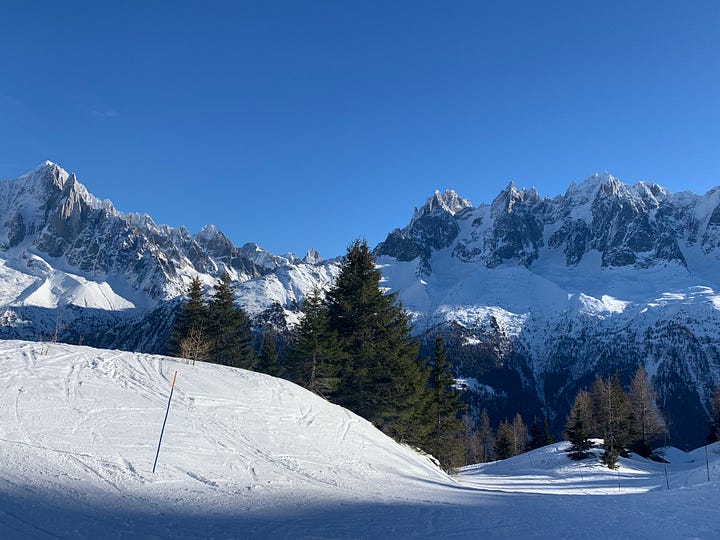
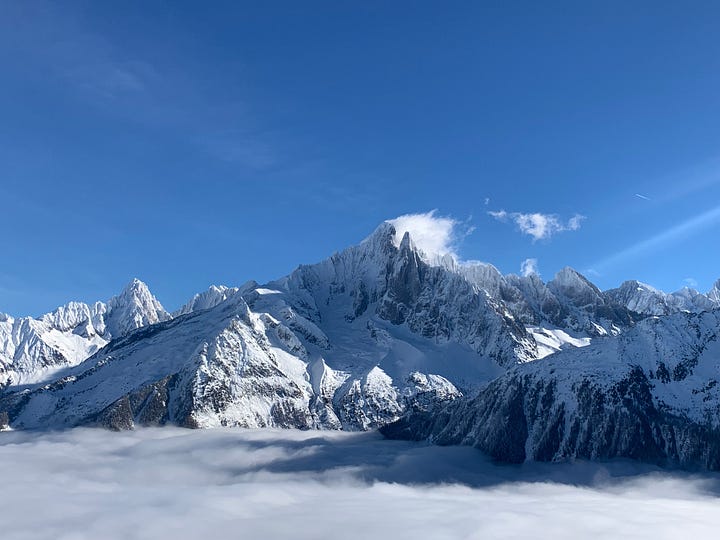
The town: Cham’ is a real mountain town. It has tons of excellent bars and restaurants, a great après scene and on-slope bars for skiers and pedestrians. There’s a wide range of food, from excellent local Savoyard to some killer Nepali. The bars are really fun, without being too crazy—perfection in my eyes. The aesthetic is alpine and cute. It’s very walkable with free buses connecting the town center and the outlying hamlets. Accommodations run the gamut, so chances are you’ll find what suits you. Snowshoeing, ski touring, paragliding (highly recommend!), and spas are just some of the other activities to do while visiting in the winter.
Tignes-Val d’Isere
Summary: My favorite all-around ski station in France so far. It’s easiest to drive there, but buses and bus+train journeys are possible. This resort is very snow sure, and it’s an excellent place to go for several days of high-quality skiing with tons for intermediates and advanced skiers plus a handful of other snow activities and paragliding. We stayed in Tignes and had solid food options, and the heavily British crowds brought some zest to the après (read: can get a little rowdy but fun). I loved it and am looking forward to going back. You feel like you’re on vacation, because everyone else is too. Can be pricey, so book early.
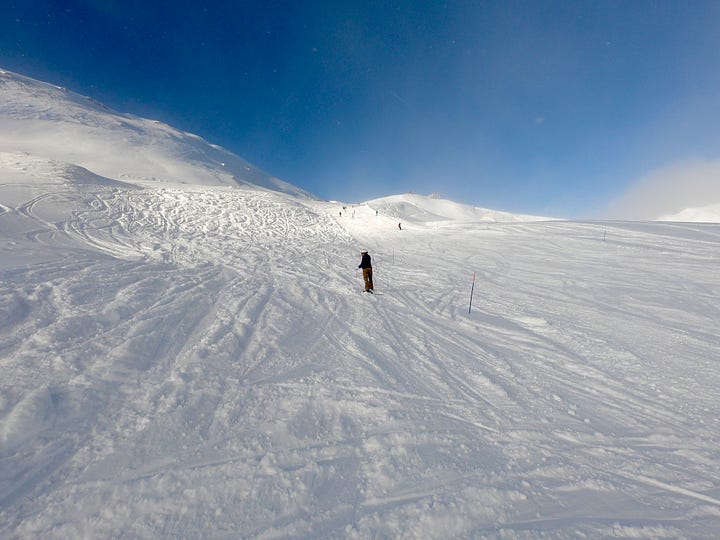
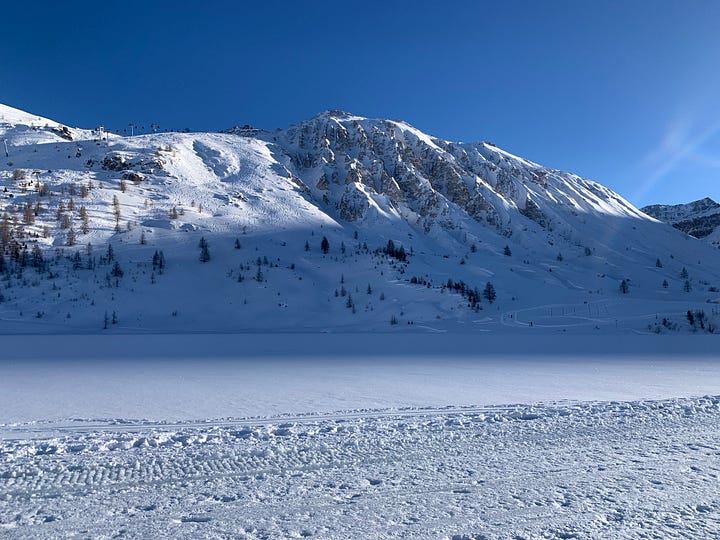
Ski conditions: I really loved the terrain, with blues and reds that were challenging enough to feel like I was pushing myself a bit but still very much in control. A lot of pistes/slopes can be connected to offer really long descents on excellent snow. That said, moguls form quickly with all the fresh snow and people, even on less steep pistes. It can be fun but nerve-wracking! There’s also highly accessible glacier skiing, a great lift system, and decent food on the mountain. Val sits around 1800m and Tignes is between 1800 and 2100m, so they have a long season and it’s pretty cold.
The towns/resort: Often described as “sporty” Tignes and “fashionable” Val d’Isère, these two linked resorts both offer great restaurants and après with nice accommodation, including the original Folie Douce in Val d’Isère. I will say this now—you can’t go wrong with either as an average vacationer. Tignes has excellent ski-in/out while Val d’Isère has a little more alpine charm, a bit more of a party scene, and there’s (kind of sketchy) pistes into the resort. Both have plenty of restaurants and bars. If you want more of a party atmosphere, go to Val. There is no bus connection between the two into the evening and night, unfortunately, so I’d say choose based on your going out preferences. Both are very pretty in winter, and it’s simply untrue that Tignes isn’t charming. It’s slightly more modern, but has plenty of character in its own right. The access to slopes from the accommodations in Tignes is unbeatable.

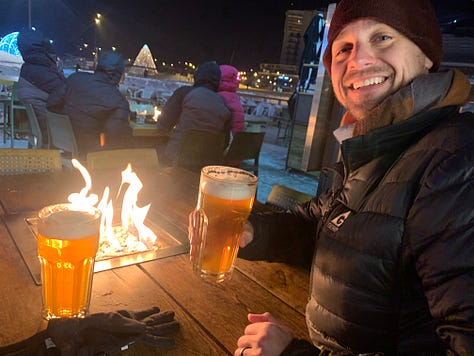

Alpe d’Huez
Summary: I would go for a day trip again to give it another try, but it seemed a little rough around the edges. People love this place, so maybe I caught it on a bad day. The skiing is good for mixed ability groups, and it errs warmer since it’s south-facing. I’d suggest it for a day trip as the resort seemed slower than others and the food we had didn’t impress.
Ski conditions: The terrain is a mix of accessible, easier skiing and some tougher runs, with the longest black run in Europe, La Sarenne at 16 km long. I didn’t do it since that’s above my ability and comfort, but it’s there. The snow was slushy at times and a bit more sparse when we were there, giving some credence to common complaints about the south-facing slopes. For reference, we went in February 2024 when there had been quite a lot of snow across the French Alps.
The resort: To me, it’s just another purpose-built ski resort. The food wasn’t as good as I’ve had elsewhere, and the infrastructure largely seemed a bit dated. The après didn’t seem to be really vibrant, either. Everything was just…fine.
Courchevel
Summary: The way people hype up Trois Vallées I think sets unrealistic expectations. Courchevel has nice, easy skiing in beautiful surroundings—but not exceptional compared to the rest of the Tarentaise. I wouldn’t want to stay there (seemed kind of boring and some other visitors insufferable). If you want quiet, just want to ski, and are renting an apartment then consider here. However, it’s a “been there, done that” place for me. I will only go back to Trois Vallées to try out Val Thorens and Les Menuires.
Ski conditions: The snow quality was good and the skiing was pleasant. I’d say it’s an easier resort with a lot of leisurely descents. Of course there are some steeper places, but I can see this being good for beginners and kids, and mixed groups would probably also be more than happy skiing here.

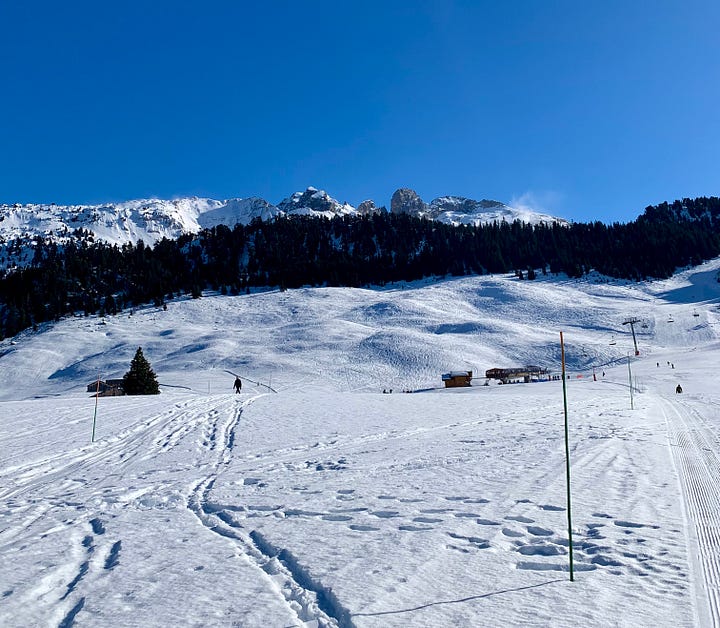
The resort: Courchevel itself didn’t strike me as boujee as people make it out to be, although it’s expensive and a few people were clearly there for the appearance of it (the hallmark lip filler, too much makeup, obnoxiously posing for photos in the middle of ski slopes…you know ‘em.) There are smaller, scattered pockets of varied lodgings and few restaurants without a larger, central “village”. It’s definitely not a going out kind of place. Accommodations are heavily skewed towards apartments but there were also hotels.
Paradiski: La Plagne and Les Arcs
Summary: My favorite skiing happens to be last! Rolling, long pistes and beautiful scenery are what sells Paradiski, whether it’s from a mountain top or lower in the trees. Difficulty ranges from easy to challenging with a LOT for the intermediate skier. Even though I love the incredibly relaxed skiing here the most, the on-mountain resort atmosphere is also just another purpose built ski station. If you value a better village vibe over ski-in/out I would recommend staying down in Bourg-Saint-Maurice where there’s more going on and take the funicular from there to Les Arcs and ski all over the domain from there. The lift structure and pistes are well-connected. Or, drive to a parking area closer to La Plagne and start from there. The area is great for a day trip or a few days of skiing. Transport can be done by bus, train, or car.


Ski conditions: While La Plagne may be slightly steeper than Les Arcs, both have tons of long, cruisey blues, and the scenery is 10/10 (mountain peaks caked in snow high up, trees down lower). Some blues and reds can give people like me a bit of a challenge on sections while others glide through trees and I’m surprised they’re not green. The varied terrain is overall just really enjoyable and I find most pistes, especially in La Plagne, a great balance of fun and ease.
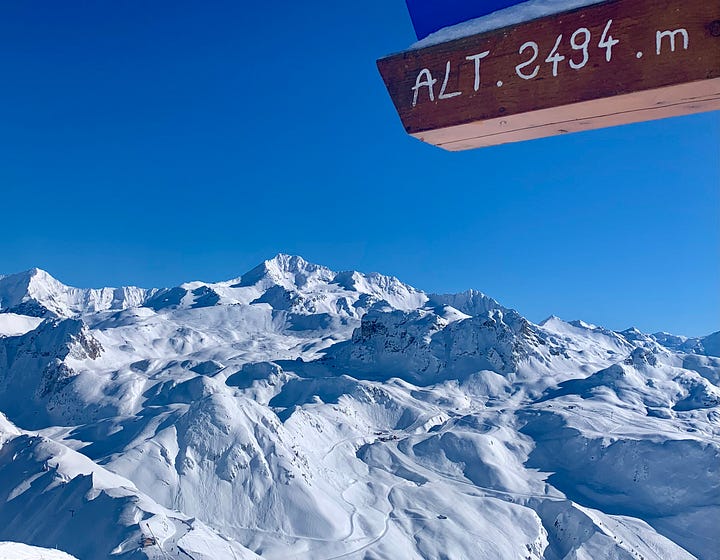

The town/resort: These are purpose-built resorts from ~ 1970s. Enough said, right?The on-mountain lunches were good and there’s a small selection of bars and restaurants scattered throughout the various parts of the station, but I would prefer to overnight down in the valley. From there either take the funicular up the mountain in the morning for a few days and then simply drive to any number of other ski stations in the beautiful Tarentaise Valley for more. The funicular is a 5 minute ride, maybe a 5-10 minute wait to board. The train station is in the middle of Bourg-Saint-Maurice and this is where buses drop off, so it also makes great sense if you don’t have a car.
*Bourg-Saint-Maurice is also an amazing place for the summer, with waterfalls, hikes, rafting, and mountain biking easy to do/get to straight from town.*
Staying outside of the resort areas/off mountain
If you want to do a little more than ski in the Alps, there’s a solid network of private companies and regional transport that take people from French cities and towns to the mountains for the day. You can also do this from parts of Switzerland. Skimania is a company we have used multiple times and enjoyed due to the the ease and excellent value. For anywhere from 55-75 euros per person, they provide transport to the resort, mountain accident insurance for the day of your trip and the lift ticket. It’s hard to beat. Of course, renting a car is also very doable.
Cities like Lyon, Grenoble, Chambéry, or Geneva (Switzerland) would be great bases or add-ons, and from there you would have very easy access to the French ski stations.
Where are you headed next? Let me know and happy skiing!

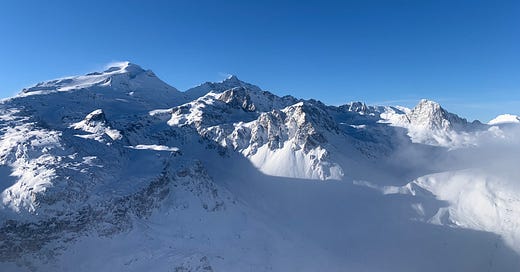







love this. this is what i miss about the internet. blogs and writing of experiences and not for influence. can't wait to read more. i may do the same. :)
This was a fabulous re ire/overview. I always love getting these and hearing about y’all’s adventures. Especially skiing!